Excerpts from
A Most Merry and Illustrated
History
of
The Last Days of Pompeii
Unabridged Edition Available from Amazon
KindleTM Paperback
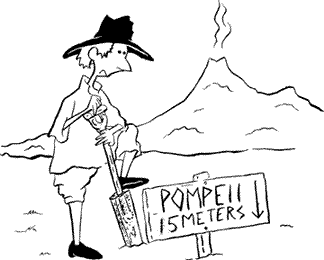
Pompeii - A tourist trap since 1748
Without doubt the most famous city of antiquity is Pompeii. As everyone knows, it was destroyed on August 24, 79 AD during what was the first recorded eruption of Mt. Vesuvius. Serious excavations began in 1748, and it's been a tourist trap ever since. All schools teach about it, and just about everyone would like to go see it.
Historians might wax eloquent about how Pompeii is a city - quote - "frozen in time" - unquote - and how the eruption was a blessing in disguise for later generations. But the Roman's themselves saw the destruction of Pompeii and the neighboring cities - quite correctly - as one of the worst natural disasters in the history of the world. The Roman civil servant and author, Pliny the Younger, was a teenager who lived across the bay at Misenum when it all happened, and in later years he wrote an account of it to his friend, the Roman historian Tacitus. The two letters make for pretty harrowing reading. Although Misenum was further away and out of line from the prevailing winds, the ash cloud still managed to reach Pliny's home, and everyone around thought they were going to die. It was decades before the area around Pompeii began to be resettled.
Still things could have been worse. Although newspaper stories today sometimes blare out how "20,000 people died", that's probably an upper limit based on one estimate of the town's population. The trouble is no one really knows the how many people lived there. The 20,000 figures seems the most common, but others give it as low as 10,000. In any case, an educated guess is that there were no more than 3500 victims in all, and in Pompeii maybe 1600 - 2000 didn't get away. It's also likely that a number of those trapped in the town had actually left and just returned too soon. It's also been suggested that at least some of those caught in the final blast were actually going through the town ripping off valuables, and you might argue, simply got what they deserved.
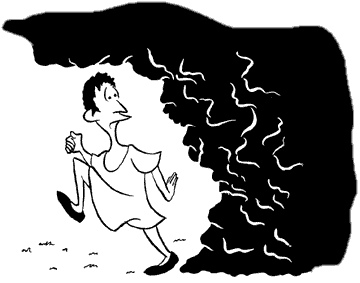
Things could have been worse.
Although Pompeii has given us the best glimpse we have of daily life in a Roman city, it might NOT have been your typical town. For one thing it was a mess. In A. D. 62, it had been hit by an earthquake which pretty much flattened it. Even after seventeen years, large parts of the city were still unrepaired. For instance, neither theater was useable and only one of the town's three public baths had been fixed. There's debate on how much of the forum had been restored - some people say most of it, others say not much - but the large open covered market was in use and the amphitheater (used for gladiatorial combats) was one of the first structures brought back into service.

Pompeii was a mess
Pompeii was also a resort town and center of commerce. Rich people went there to get away from the hassle of living in Rome, and ships put in to the Bay of Naples from all over the world. So the prosperity and aura of enjoyment that seems to have prevailed might not have been shared in other more workaday towns. But some authors believe all was not peace and harmony in Pompeii, either. With an excess of rich people, there was likely a big-me/little-you schism with the ordinary townfolks. Perhaps. But you had the same thing in Rome, and from the looks of what's left, the people in Pompeii certainly knew how to enjoy themselves.
Getting Up
The last full day that Pompeians would enjoy was August 23, A. D. 79. We know this since Pliny saw the ash cloud ante diem nonum kalendae Septembres - that is, nine days before the beginning of September. That translates literally to the 24th of August, but there's some room for scholarly discussion here.
For one thing, historians aren't entirely sure how many days were in each Roman month. They THINK they're pretty much the same as ours, but there's enough doubt for any given date to be off by a couple of days. Another problem was Pliny was using the Julian Calendar. If you convert to our own Gregorian version and shift the days, August 24 ends up being August 22. Not too far off, but not the same date written down by Pliny.
Pompeians, like most Romans, rose early. If they were well-to-do or of the respectable middle class, they would have a slave wake them up and help them dress. That last part seems strange since their clothes were simple in the extreme.
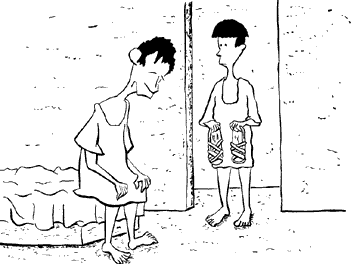
The Pompeians rose early
For EVERY Roman, rich, poor or middle class, the main piece of apparel was the tunic. Usually made of wool, this was simply two pieces of square cloth sewn together leaving holes for the head and arms. Since it was as broad as it was wide, it hung loosely on all but the most hefty frame. The cut was such that the excess cloth formed sleeves of a sort, and the appearance was like a long t-shirt that dropped somewhere between mid-thigh and the calf. The women's version was longer and all tunics were usually belted at the waist and produced a chic look which was surprising in something so simple.
The other garment was, of course, the toga. None of the original togas have lasted down to today, and from what you read today, you might wonder if scholars know exactly what a toga was. Oh, it was a sheet of cloth, sure, but some people say it was just a large rectangular blanket of wool; others say it was circular or semicircular. The truth is since it was just draped across the body it could have been almost any shape. From looking at statues, it seems like all of the guesses are correct and that the cut changed with time.
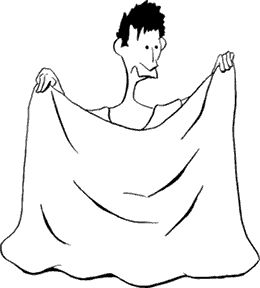
The toga's cut changed with time.
Despite popular opinion, your typical Roman did NOT walk around in these heavy, clumsy, and quite impractical woolly burdens. In fact, most people were not allowed to. Toga's were reserved for only two classes of people and two classes only.
The first group was male citizens. And even they didn't always wear a toga if they didn't have to. It was a pain. You usually DID need help in putting them on, and if you didn't hold your arms right, it might slip off. Togas were such a bother that the emperors had to keep issuing decrees reminding the men that they had to wear them at official functions. Like all dress codes, this was unpopular, but you generally did what the emperors said, particularly if they were homicidal nuts like Caligula or Domitian.
The second class of citizens permitted - or rather ORDERED - to wear the toga were the - ahem - "ladies" plying their avocation. No one knows exactly why. And it is kind of odd - but to modern readers rather satisfying - that both politicians and prostitutes were ordered to wear the same uniforms.
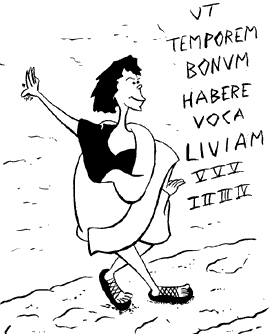
Togas were for two classes of Romans and two classes only
The toga grew increasingly unpopular, and as Roman citizenship became more ubiquitous, it was less and less a badge of distinction. After a while people began to give it up, and you got away from Rome, even the uppercrust shed their togas. At Pompeii - being both a provincial town AND a popular resort - most men could have gotten away with a tunic.
The ladies' tunics tended to be a bit longer than the men's and there were two kinds. Called here by the Greek names, one was the peplos and it was kind of like a cloth tube. Both ends were open and clips fastened the garment together at the shoulders. The other was the chiton and it was cut similar to the peplos but was much wider and several fasteners held the shoulders together. It formed a very loose, drapery style full length dress.
Over the peplos or chiton the proper married ladies put on the stola. This, too was a version of the tunic. The closest thing women had to a toga was called the palla. It was quite a bit simpler, more of a large shawl, but it was draped around the body in a similar fashion.
But however you dressed the next part of the day was a light breakfast. Today your mother will insist that you MUST eat a GOOD breakfast or you'll collapse from hunger, but the Romans preferred to go easy. Usually this was nothing more than a piece of bread, maybe dipped in wine (drinking wine in the morning was OK - it was diluted with water). It was pretty informal. A man might breakfast by himself (less commonly with his family) or he might just pick up a bite in a snack shop. The Romans liked fast food for the same reasons we do. Preparing food takes time, and there are usually better things to do. At Pompeii there were plenty of shops along the streets. They had curbside counters so you could just pick up something and munch as you walked along.

The Romans preferred to go easy.
Clients and Patrons
Once you were dressed and ready for work, you had one duty to perform that has no real modern equivalent. This was the morning ritual called the salutatio. You had to pay your respects to your "patron". Or - as a patron - you stepped outside to receive respects (and give out a dole) to your "clients" gathered about your door. Virtually everyone in Pompeii was a client or patron to someone, and many were both.

The client/patron system - it lasted because it worked.
The client/patron institution developed because throughout most of Rome's history there was no government executive or enforcement agencies. So although there might be laws protecting citizens, rarely were there police who bothered to enforce the laws.
As Roman society became more and more complex and organized (but oddly more anarchistic), those in the lower strata of society tended to attach themselves to someone in the powerful uppercrust. When you did this, he was your patron, and you were his client. After a while there developed the ritual where each day the clients and patrons would meet early, the patron hand out a small gift (food or money usually), and the clients would take the present and either leave or stick around, depending on what the patron wanted him to do.
The result was a more or less formal institution, sanctioned by law, that entailed obligations on both sides. The patron provided support and protection for the clients, and the clients formed a loyal following who would do the bidding of the patron. That could be simply providing him a cheering section when he argued in court or made a speech, or it might be following him around so he'd look like a big shot. Even better, if the patron selected them right, he had a group of strong-arm toughs that were quite useful when he wanted to muscle in on someone.
That happened pretty frequently. The Roman Empire had plenty of laws, but it was not RULED by law, at least not as we understand it. It was, as one historian pointed out, more like the American Wild West. Even that comparison isn't extreme enough unless you're talking about the times and places of virtual anarchy like Lincoln, New Mexico in 1880 or Johnson County, Wyoming in 1895.
And what happened could be pretty similar. If a rich landowner wanted a small farmer's land, he didn't have to bother making an offer that no one could refuse. He'd just have some of his more robust clients ride up to the farm, kill all the slaves, and toss the now former owner out on his ear. As long as only slaves were killed and their owner was just beat up, this remained a civil - not criminal - matter.
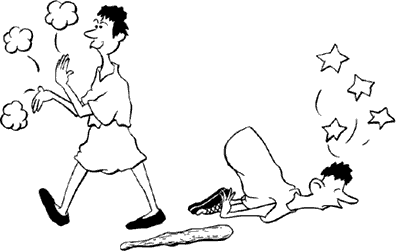
A civil matter
Now the small landowner would have recourse to the courts, but with no police, constables, or marshals, he couldn't even guarantee the defendant would show up. So he would go to his own patron who would get together a group of HIS rougher clients and kidnap their adversary (again not necessarily a crime). They'd haul the fellow to the patron's own private jail (yes, you could have a private jail) and keep him on ice until it came time to go to court. Naturally the other guy's clients wouldn't like this and some real set-to's happened from time to time.
In the end, the client/patron system lasted because it worked. Although the poet Martial was famous for his verses throughout the empire, he earned his day-to-day income just by being a client. He griped about what a pain it was making his rounds, but another poet and satirist, Horace, had his patron, Maecenas, who was a good buddy of the emperor Augustus, get him a full-time job as a clerk. For many Roman's there was no work and in Rome itself, unemployment was often at 50 %. That was probably NOT the case at Pompeii where there seemed to be plenty of jobs.
Off To Work
Although there had been earth tremors going on for several days, these were, as Pliny pointed out, quite common in the region, and no one gave them much thought. So after dressing, eating breakfast, and handling the client/business stuff, the Pompeians set off to work.
You didn't have far to walk. If you were a simple tradesman, your shop would almost always be on the street front where you lived. Such a shop was called a taberna and is not to be confused with a tavern in our sense. It could be, but any street front shop where the owner lived in attached rooms was a taberna.

You probably didn't have far too walk.
Most townspeople lived in apartments. These might be attached to the homes (or what used to be the homes) of the more well-to-do. Some of the fanciest houses that have been excavated in Pompeii took up a whole block.
The apartment buildings were called insulae (literally, islands) and they were crowded. Pompeii wasn't as bad as Rome (or New York) where the only way to expand is up, but still, if you were poor you had to live on an upper floor. Without elevators and no fire escapes, the poor lived on upper floors and the rich on the lower - the opposite of what we usually see today. The ground floor might be occupied by the actual owner of the buildings.
If you didn't live next to your shop, you set off on the streets of Pompeii. During the day you had to walk since it was forbidden to use a wheeled vehicle during the day. Besides the streets were pretty bumpy, and anyway Pompeii, like most provincial Roman towns, wasn't all that big.
Today people on the way to work might pick up a paper to catch up the latest news. The Pompeians did the same thing, but not exactly. Without newspapers, radio, television, or other electronic communication what you did was to check out the most recent graffiti. The walls of Pompeii are filled with the scribblings of the townspeople, and there was nothing illegal about it. It was a perfectly acceptable means of self-expression.

A perfectly acceptable means of self-expression.
In Pompeii, the quality of the writing - in appearance and content - varied considerably. Some graffiti was written in an absolutely beautiful script and might wax poetic about the spiritual side of the human condition. Going down the rung in topics, electioneering was fair game and individuals and organizations would tout this-or-that candidates. There was plenty of negative campaigning as well, some of it with the intelligence and good taste rivaling that of our own modern elections. And of course, you had the Latin version of "Marcus + Julia" and the omnipresent boasts of masculine prowess that, like today, were mostly in the mind of the beholder.
On the Job
In Pompeii when you actually started work depended on the job. Although you may hear that work for the Romans began the third hour after dawn (determined by the unequal divisions of the sundial), that was more when the businesses - or most of them - actually got going. The fast food joints no doubt opened earlier to accommodate the commuters and like today bakeries had to start well before everyone else got up. For the wealthy, many of whom handled a lot of business out of their houses and had to deal with the client/patron stuff, the work day was necessarily more flexible. But in Pompeii and elsewhere in the Roman world, a respectable job usually meant one thing. You didn't work.
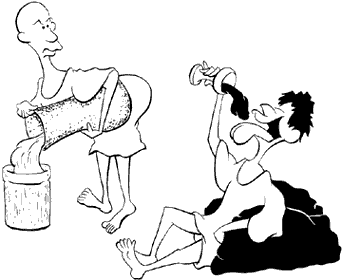
A respectable job
So it's no surprise, then, that being a lawyer, politician, or business executive put you on top rung of the job ladder. In Rome itself, like today in Washington, D. C., daily life was geared toward politics. So for a good chunk of the Capitol City's better citizens "going to work" meant you'd troop off to the forum and take part in (or at least watch) prosecutions, defenses, or lawsuits. But in a resort and manufacturing town like Pompeii, the legal profession would not have had as an all-pervading presence as in the Capitol City. Without their entourage of clients, the lawyers probably wouldn't have had that much of an audience anyway. Besides entering the Roman bar was really just a way to get known so you could end up getting appointed or elected to some - and almost always unpaid - government job.
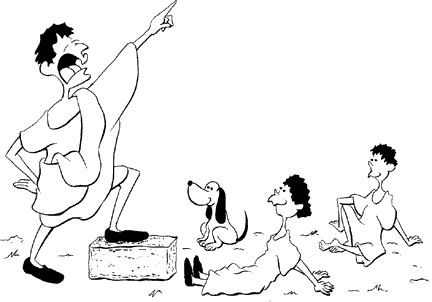
Not much of an audience
From the graffiti we know there were plenty of politicians in Pompeii. Just like today, you had to be rich to pursue a political career. But again then as now, begin a politician was a great way to get richer. Even though virtually all elected officials got no pay, once in office you expected (and got) kickbacks and payoffs or by greasing your palm in any other way you could think of. Again all this wasn't necessarily illegal and was simply the way business was done. But there was one major advantage of being an elected official: you couldn't be prosecuted for anything, at least as long as you continued in office.
Not everyone could be a politician, though, and other options were available. A quite prestigious job was being one of the big land owners - agriculturists, we'd say today - who ran farms, ranches, and owned the vineyards (wine from the slopes of Vesuvius was considered quite good). We really don't know much about these people and as like as not, many of the big land holdings were owned by absentee landlords.
So what remained for most Pompeians was to run a business. Again this could be respectable enough provided you didn't have to actually do the work yourself. The most prestigious trades were the large scale buying and selling, importing and exporting, and this type of job could put you at the upper levels of society. Although these nouveau-riche entrepreneurs might have been sneered at in Rome, in Pompeii they seemed to be held in high enough regard.
We know a fair amount about some of the richer businessmen in Pompeii, mostly because their houses have been excavated. One of the most prominent was Lucius Caecilius Jucundus who lived in a house known as (what else?) the House of the Lucius Caecilius Jucundus. He is often called a banker but seems to have been more of an all around businessman, agent, and broker.
A number of Lucius' business records have been found, recorded on the booklets of wax coated wooden slates that served the Romans as account sheets. He was a long time resident of Pompeii, and almost a quarter of a century before the eruption, he had handled an auction for a lady named Umbricia Januaria. This netted Umbricia 11,039 sesterces (the Roman dollar), and you can be sure Lucius himself had taken a generous percentage. An even more interesting transaction was when Lucius gave a slave named Privatus 1000 sesterces for rent of a pasture. Rather than soiling his own hands dealing with a slave (who himself seems to have been a middleman for the city authorities), you can bet Lucius worked through his own middleman, who would also have been a slave.
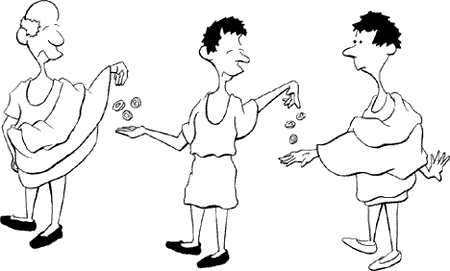
Lucius worked through this own middle man.
The Slaves
In Pompeii, as in all ancient societies, slavery was considered absolutely necessary. It's often said that Roman slavery wasn't quite as bad as later forms (such as you find in ante-bellum America), and in some ways that's true. But it could be grim enough. Slaves had no rights, slave marriages and families had no legal standing, and slaves could just up and be killed by their owners if there was a "just" reason for it.
The slave trade was big business and a slave could cost from a low 1200 sesterces (about a year's salary of a Roman legionnaire) to two to three million sesterces. A more typical cost for a skilled or otherwise desirable slave was 5000 - 10000 sesterces, and slaves with special skills such as teaching or music could run to 20000 sesterces.
So despite the expense, many people owned slaves. Since men did most of the shopping, if a husband generously his wife needed more help around the house, he could head off to the market place. He'd bargain and haggle for a good price and then take his purchase home. Like men shoppers everywhere, no doubt his criteria were different than his wife's, and we can understand why women eventually became the traditional shoppers for the family.
It should also be realized that you did not have to buy slaves actually. The Latin word for slave, servus, originally meant a "spared", "saved" or "preserved" person. Only later did the meaning of servant and servitude take on secondary meaning. In Roman law there were certain people who should have been dead, but were not and these are the people who first became the source for slaves.
Prisoners of war was the earliest source of slaves. There was no Geneva Convention back in Roman times and the usual practice was to kill all the captured soldiers. However, you could spare them and they became slaves. Usually it was the commanding general who tehcnically owned them. He could ransom them back to their families or sell them, and possibly give a couple of slaves to a soldier who had performed well in battle. People who had committed crimes (and most crimes could be punished by death, particularly if committed by non-citizens) could also be spared and turned into slaves. This was in fact a main source of gladiators.
Certainly among the most objectional (by our standards) source of slaves was unwanted children. Unwanted children could be "exposed". That is, you could quite literally take the kids out and leave it in a remote and wild place, often tied to a tree so they wouldn't wander off. If someone came across one of these "exposed" chidlren soon enough, they could take the child as a slave. Again this fits in the definition that an exposed child was legally dead and by taking it in, you "spared" it. Despite the elegance you see of Rome in the movies, it could be a brutal and cold-blooded place.
Finally people could more or less volunteer to be slaves. This usually happened if they owed someone money and couldn't pay up. So they became their creditor's slave. Also if you had to pay a debt the father - who had absolute control over his family - could sell one of his children as a slave.

Why women became the traditional shoppers
It has been estimated that maybe 30 % of the population in Italy were slaves, and it was the slaves who ran the businesses of the well-to-do merchants. Often they got paid (they just couldn't quit if the wanted to), and it was quite typical for a slave to buy his freedom and continue running the business. It was also standard practice for owners to free a slave who had served them well. Eventually so many slaves were freed that Augustus decreed a man could not free more than 100 slaves and none before the age of 30.
Like the slaves in America, Roman slaves only had one legal name. But if a slave was freed he adopted the first two names of his former owner. So if a slave of Lucius Caecilius Jucundus was named Fred (or whatever), he would have become Lucius Caecilius Fred. He would also become an official client of his former owner. So unlike in America's version of slavery , there was a smooth translition from slavery to freedom.
Once a slave was freed, he was called a libertus or freedman (a freedwoman was a liberta). The liberti did not quite have the status of full citizens, but their kids had more rights than they did, and their grandchildren were full citizens. This is the oddest part of the Roman institution. Not only did descendants of freed slaves enter the normal population, but they entered into the most privledged class of the population. A third generation descendant of a slave could even become a senator, and it wasn't unusual for a slave's children to acquire riches and power. In fact, Lucius Caecilus Jucundus' pappy had been a slave.
Like a lot of rich folks a generation removed from humble parents, the kids of a former slave could be real snobs. We don't know if Lucius was, but Pliny wrote about a man named Larcius Macedo, who like Lucius, was the son of a freedman. Larcius (not Lucius) treated his own slaves so horribly that they finally had a bellyful of him.
Pliny gave the details of how when Larcius was in his private sauna, some slaves surrounded him. From their looks he knew that they weren't bringing him extra towels. Instead, one of the slaves grabbed Larcius by the throat, and the others punched him in the face and stomped on his chest, stomach, and to quote Pliny's polite euphemism, "the parts that are held in reverence". Then to make sure he was dead the slaves to fry him on the floor (the floors of Roman saunas were heated by a fire and you even had to wear thick soled sandals ). After Larcius cooked a bit, the slaves dragged him outside telling everyone they had found him unconscious.
The trouble was Larcius started to move and his eyes flickered open. So his assailants realized they had botched the job and skedaddled out leaving the others to try to revive their soon-to-be-former owner. Larcius did live on for a few days and managed to see a good chunk of the guilty slaves captured and executed.
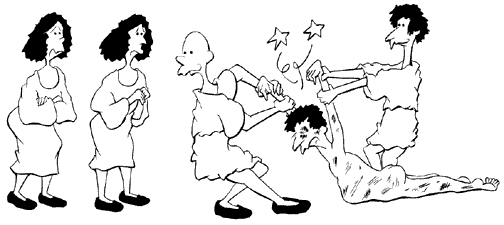
They said they had found Larcius unconscious.
We don't know what happened to the other slaves. Legally if they were within earshot of Larcius, they were supposed to be executed along with the others. That law, though, was not popular, and once in Rome a city prefect under Nero named Lucius Pedanius Secundus (there were a lot of Lucius' around) was killed by one of his slaves. The law was invoked that all the slaves - regardless of age or sex, guilt or innocence - had to die. The townspeople rioted and tried to prevent the executions. But soldiers were sent in and all the slaves were taken away and killed. It's hard to tell how often the law was enforced, and there's nothing in Pliny's letters to indicate that any of Larcius' innocent slaves were harmed.
Despite the inequities, the slaves living in Italy were integrated into the population in a manner that surprised foreign visitors. Slaves dressed the same, ate in the same restaurants, and attended the theater and other entertainments right along with the free citizens. This mixing was probably even greater in Pompeii where a number of the richest and most prominent citizens - and not only Lucius Caecilius Jucundus - were only one generation removed from slavery.
The Businesses
In Rome, with it's politicians, lawyers, senators, and emperors being the main attraction, owning a business was generally looked on as a low class job. But because Pompeii was a center of trade, being a businessman there seems to have been respectable enough. Or at least it was lucrative, and even if you were originally from a humble background, you could move up to wealth with all its trappings. This meant fine clothes, a good marriage, and above all, having your own home that took up (at least) a whole city block. One of the fanciest houses in town was owned by a man named Aulus Umbricius Scaurus. Aulus was a garum maker.
Garum was the innards of fish that were salted, rotted, and had liquefied. It was the Romans favorite condiment and isn't really quite as grotesque as it sounds. It is somewhat similar to Wochestershire sauce, but much more akin is the Thai nam pla or other Southeast Asian fish sauces which are prepared pretty much the same way.
Garum, by the way, was absolutely essential for the Roman cuisine and added a sharp, salty taste to what was usually a pretty bland diet. Real garum was expensive, but fortunately, a little went a long way. There were also cheaper variations, and a variety called liquamen was particularly popular.

A little garum went a long way.
People were not, by the way, allowed to make garum in their own homes since even when profitable the business literally stunk. The miasma wafting from the jars with the festering fish was so fetidly foul that some towns even banished garum makers to the outside the city limits. We know this was NOT the case in Pompeii since archeologists excavating one of the city's insulae recently discovered a garum factory. Or rather they found a jar with a whole fish skeleton. As the fish wasn't too big (about the size of an anchovy ) and up that time all the fish bones uncovered at Pompeii had been pretty fragmentary, it is indeed likely this was a site where garum was manufactured. To the layman finding a tiny fish may seem like pretty small potatoes, but the archeologists sure seemed happy with it. They even issued a press release.
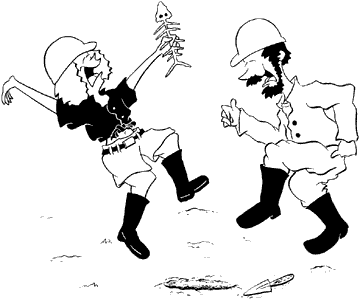
The archeologists sure seemed happy.
Pompeii's garum was considered the best in the empire, but other trades also kept the city going. From the excavations we know there were butchers and bakers, restaurateurs and innkeepers, glassblowers and potters, bankers and millers, weavers and fullers. The last profession was one of the most important in a town where it was needed to keep everyone looking spiffy.
A low capital, high volume bioprocess
It's fair to say that the bleach used by a fuller in Pompeii was about the cheapest raw material ever invented. What the fullers did was just put a good size jar out in the street, and anyone coming along could just stop and avail themselves to the convenience. When the jar was brimming, the fullers would bring it back to the shop and pour it in a low wide vat and throw in the cloth. Then the workers (slaves, of course) would tromp on the cloth until it was thoroughly soaked. Then if more whitening was needed, they would hang the garment on a wicker frame and smoke it with burning sulfur. You can see why Roman's didn't mind the smell of garum.
Once the cloth was bleached it was given a final wash and hung to dry. Drying outside no doubt helped add a hint of freshness for the customer. A hint.
Paintings in Pompeii show the fullers at their work, looking a lot like the traditional image of the wine makers as the basic process of both professions was treading the product with their feet. Which brings to mind a joke the Pompeians might have told. "Hey, Marcus, what's the difference between a fuller and a vintner?" "Gosh, Julius, I don't know." "Well, then, Marcus, I'm sure not drinking wine at YOUR house."
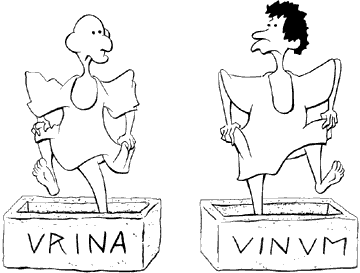
Fullers and Vintners
Well, if Julius' wine WAS that bad, then Marcus didn't have to stay. He could just have trooped off to one of the many bars, restaurants, or inns.
Bars, Restaurants, Hotels, and "Other" Services
What is now called "food service" was a thriving industry in Pompeii. This makes sense as there were a lot of people passing through, both for business and pleasure. The restaurants ranged from hole-in-the-wall bars to fancier establishments in five star hotels. In many places, food wasn't the only thing offered.

Food wasn't the only thing that was offered.
Romans preferred to eat laying down. In Pompeii's private houses, archeologists have excavated dining rooms where couches were arranged around the walls so people could recline on their sides and grab the food that was placed on a table in the middle of the room. Although you had this arrangement in some fancier restaurants, cheaper places had counters, tables, chairs, and stools.
It can be quite a challenge to the uninitiated in sorting out the different types of restaurants and hotels. In fact even specialist can be confused, and Roman philologists sometimes trash the lowly archeologists who cavalierly bandy the various establishments about. Was this a popina or a caupona? Maybe it was just a lowly thermopolium? Or shoot, could it even have been a diversorium?
One of the most famous restaurants in Pompeii is a thermopolium. Restaurant here is really a misnomer since it's was more the equivalent of a bar. You probably could get a quick snack, but mostly you went to get a drink.
Wine was the preferred drink in Pompeii as it was in most of the Roman world. Since that was pretty much all there was, a lot of creativity went it to how it was served. There were sweet wines and dry wines, and wine that went bad was just sold as vinegar. You could get heated wine (where a thermopolium got it's name), and there was chilled wine, wine with herbs and spices, and wine that had been sweetened with honey. This latter drink was called mulsum and was a particular favorite.
The wine was kept in jars in sunken counters where was diluted with water. This custom surprises today's connoisseurs. But it's true. Both the Romans and Greeks diluted their wine. In fact, they didn't like uncut wine at all and considered it quite gauche.
Each wine had a different water requirement; heavy wines took more water than light wines. But in general you added about two to three parts water to one part wine. If you try this out at one of today's restaurant (when the maitre'd isn't looking) you'll find you have a quite mild drink which is a better thirst quencher than pure wine. It doesn't taste half bad. The alcohol content is lower than most beers, and so the ancients could quaff this stuff fairly steadily and still function more or less normally. Naturally the tradition of diluting wine could be abused, and there are graffiti where people complain about the wine being cut too much.
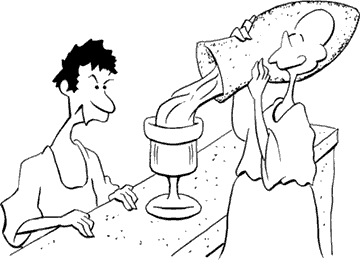
The custom could be abused.
Moving up the ladder of culinary establishments was the popina, although the actual distinction between a popina and a thermopolium seems subtle. Usually you went into a popina to get a meal, and the word can be translated pretty accurately as "restaurant". Popinae varied in size, in some the dining rooms were maybe six by fourteen feet or smaller. Others were larger and one not far from the amphitheater had an shaded courtyard over 60 feet long and half as wide.
If you needed a place to stay you could find various types of hotels. The simplest was called a caupona. The guests expected (and got) other entertainment as well: food, drinks, gossip, gambling, and (upon request) feminine companionship. This was also the case at some popinae, you just didn't have place to sleep. Since the layouts of popinae and cauponae are often similar - a small room for eating and drinking with rooms off to the side - it's hard for archeologist to tell what they have. It's mostly intent. If the rooms were for sleeping, that would be a caupona. If you had the other stuff but not overnight accommodations, that was a popina.
A caupona might be thought of as a Roman sleazy motel - inexpensive, no-frills, and patronized by the riff-raff. If you wanted something better, then you went to a hospitum or a diversorium. The hospita (literally, places of hospitality) and diversoria (places where you could divert from the road) were pretty much the same with the latter being more of what we'd call a "wayside inn". Again like a good modern hotel you had dining rooms (where you could recline on a couch like civilized people did), but unlike modern hotels (the reputable ones, anyway), there was feminine companionship available.
If you were traveling with a good size entourage you'd probably look for a stabulum. The stabula had central courtyards where you could park your carriages or mules (horses, although used in ancient Rome, were a bit too cantankerous for popular tastes), and there were facilities for stabling the animals (hence the name). A stabulum was much more like our idea of the old fashioned inns you see in the movies.
Some inns and hotels around Pompeii were really fancy - multiple dining rooms, brightly colored frescoes, and picture windows looking out over scenic views. And of course, after a hearty meal and good conversation, there was the option of feminine companionship. Now if ALL you wanted was the feminine companionship, you went off to the lupanar.
The Lupanar
When tourists today wander the streets in Pompeii they stop at the thermopolium, look through the bakery, and pause at the fullers. But the one place ALL tourists visit is the lupanar. And it was even more popular two thousand years ago.
The word lupanar (or lupanarium) is derived from the Latin lupa or she-wolf. So a good translation might be translated the "House of the She-Wolves". It doesn't take a Ph. D. in Latin philology to guess what went on there.

The Lupanar - popular with tourists, then and now.
As should be evident by now, a fairly substantial part of "service" industries of Pompeii included providing men with feminine companionship. But until the 1960's (which revealed the household of Ozzie and Harriet wasn't quite the typical American family), this was not considered a proper subject for scholarly study. Which is strange since without it you can't get a real idea of what the daily life in Pompeii (or anywhere else) was really like.
When the first archeologists came to Pompeii they were shocked, shocked by what they saw. At every place in the whole town they found explicit representations of masculine body parts - particularly ONE masculine body part - all about the town. They were everywhere - hanging from the doors (or not hanging exactly), posted on the walls of businesses, imbedded in the sidewalks, and used as spouts for fountains. There were also frescos - some expertly rendered, others less so - depicting the Pompeians enjoying themselves in mankind's most universal pastime. These, too, were everywhere, on and in public buildings, businesses, or private homes; that is, in places where everyone - and this means EVERYONE - could see them.
Everyone could understand why you'd see such stuff in the lupanar. After a few drinks, the potential customer might not be able to get down (no pun intended) to business. So a little visual stimulation might help the him along. And if he was really frisky, it might even prompt an encore.
But the trouble is the same stuff - and EXACTLY the same stuff - is found in private homes. The same statues, reliefs, and paintings were not only in the bedrooms (understandable, maybe, for newlyweds), but out in the courtyards and even in the dining rooms, for heaven's sake. It looked like it was entertainment for the whole family. This was just too much for the early archeologists to take.

Entertainment for the whole family.
Lest the modern women, children, and delicate men be corrupted (and this was ITALY, for crying out loud), the scholars destroyed many of the artifacts on the spot. Or if they thought that maybe SOMEONE might like to see them (like the museum director's drinking buddies), they hauled them off to the Museo Archeologico Nazionale in Naples where they were locked up in a special room. Most of them are still there.
Just what were the Roman's thinking when they plastered their town with pronounced body parts and pictures of naked people doing something other than striking heroic poses? To the delicate minded this would seem to provide fodder for the view that Romans really WERE the depraved, sicko, weirdoes you see in motion pictures like Caligula. But what it really means is that the Romans just didn't have the same concept - or luxury - of privacy that we do.
As we know it, privacy began to develop only with the nineteenth century. In the ancient world it was virtually nonexistent. This was, after all, an era where a moderately prosperous family of two adults and seven children might be living in a two room house. Even the wealthy who lived in large private homes were crammed in with servants, slaves, boarders, children, older parents, aunts, uncles, and even more distant relatives. There were no doors to the rooms (maybe a curtain), so it was a challenge to keep knowledge of routine biological functions hidden from certain age groups. In many cases, there was no point in even trying.
The end result (again no pun intended) was Romans saw nothing wrong with depicting perfectly normal bodily functions - of any kind. In particular the teaching that the most pleasurable natural activity was something that could not be subject to artistic rendition would have flabbergasted the Romans. And certainly the precepts of the Apostle Paul that to "marry rather than burn" was a fallback position (still no pun intended here) for those without his spiritual strengh would have made the Romans label him as a weirdo, wacko, and oddball, which of course, they did.
A side product of all this was the Romans did not classify pictures or stories of naked people into proper and improper art. That, like privacy, is a purely modern phenomenon, and even Benjamin Franklin would splatter (still no pun intended) his newspaper with scatological four letter verb or nouns that would have gotten him arrested in the mid-twentieth century. It took the Victorians to come along and make depicting nature illegal.
In short - the potential for puns in this topic appears enormous (there it is again) - the Romans saw absolutely nothing wrong with discussing, talking about, or depicting what came natural. Sure, the Romans, like everyone else, had their sets of taboos, but in general, this was not none of them.
After Work - Thermae, Cenae, Theatra, et Ludi
In Pompeii - at least the prosperous middle class - stopped work around 1:00 to 2:00 p. m. By that time they day had gotten so hot that everyone took a siesta (even the kids at school got a couple of hours off). Once your snooze was over, it was getting toward the late afternoon. So it was time to think about relaxing after a hard day of watching your slaves work. The first thing to do was to take a bath, but like so much else now done in the privacy of one's own home, in Pompeii this was a public activity.
The Baths
Although some people were rich enough to have private baths (like Larcius Macedo), most people did not. And even those who did would often prefer one of the public thermae or baths. These were not just baths, either. Instead they were like a combination of a mall with a health club and spa attached. You had the baths proper, plus workout rooms, restaurants, libraries, lounges, gamerooms, and places you could get a massage. For many, it was the high point of the day.

To relax after work, you took a bath.
There were three public baths at Pompeii, but after the earthquake in AD 62, the only one operating was the Forum Baths. And unlike the massive structures at Rome, the Pompeiian baths were not all that large. One of the hot tubs was no larger than a modern jacuzzi. A pretty good sized jacuzzi, maybe, but still a jacuzzi.
Romans did bathe frequently, but probably not everyday. A little math helps here. Not counting the kids (they weren't allowed in) or slaves (only permitted if they came to attend their owners), you probably had maybe two to three thousand Pompeians to squeeze in. So you're talking about 100 people an hour IF the baths were open 24 hours. In the normal operating hours (probably 2:00 to sometime after sundown), you'd have to cram a few hundred people in per hour. So it's an inescapable conclusion that in Pompeii a trip to the bath was not a daily ritual for everyone. Still if you a bath would be just the thing after work, then you'd go down to the Forum and pay your fee. It wasn't much and even the poorer people could afford a visit.
The first room would be the changing room. You'd take off you clothes and put them in boxes up along the wall. Above each box was a risqué painting which makes some people think the baths were the start of the evenings orgy. Actually the drawings were supposed to make the bather laugh which would protect him against the evil eye - something that you were more susceptible to if you didn't have any clothes on. Despite the idea that Roman's indulged in non-stop orgies when they weren't stuffing themselves on food or killing Christians, the baths at Pompeii were divided into separate facilities for men and women. They even bathed at different times.
From the changing room you moved on a workout room or courtyard. There you'd toss a ball around, work out with weights, or engage in a bit of wrestling with your naked buddies. This worked up a light sweat. Then you'd go get a rubdown where for a small fee a masseur would rub olive oil on your skin and give you a good pummeling to tone up the muscles. He'd then scrape off the dirt, oil, and sweat with a strigil. That was an metal instrument like a slightly curved dull knife and had a quite refreshing effect. The Romans did not have soap.
After your exercise and rubdown, you'd go into the tepidarium or warm room. Here you had a pool of lukewarm, tepid water (hence the name), and you'd take your first dip and get acclimated for the next step.
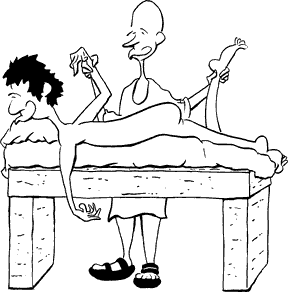
Taking a bath was not just taking a bath.
After the tepidarium (where you'd be chatting with your friends) you enter the calidarium. This was the hot room and like the rest of the baths it was heated by a series of channels and flues in the floor and walls where hot air was circulated. The hot air was from a fire that was in a side room or basement and tended by slaves was kept going all the time. Houses of the well-to-do also had this early version of central heating (hence the hot floor of the bath of Larcius Macedo). After dipping into the hot room or just sitting and sweating, you next went into the frigidarium which had a pool of cold water for a last refreshing dip. Then you'd dry off, go back to the changing room, get your clothes, and go on home.
The actual atmosphere of a bath was much more convivial than this brief description and there was quite a bit of flexibility in the schedule. Between dips you could get a massage, talk with your friends, play draughts (Roman checkers), get a snack, or read a book. Singing in the baths was OK, too, but it did disturb the neighbors.
Cena
Like us, the Romans ate three meals a day. Breakfast was called jentaculum, lunch was the prandium taken an hour before noon and like breakfast was also often no more than a snack. So after the bath you went home to the main meal or cena.
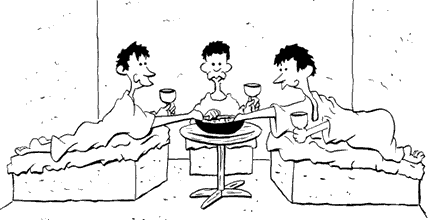
Cena - Sometimes it was just the guys.
The cena was what most people think of when they picture Romans eating. Toga and garland clad men laying around on couches with a comely maid by their side and attended by slaves pouring wine freely as the everyone stuffs themselves until they couldn't eat more. Then they could just a stick a finger down their throats so they could throw up and begin again.
First this last practice is again from a sardonic, puffed up philosopher who said simply that some people "ate so much they vomited and vomited so they could eat". Almost certainly it is not to be taken too literally and certainly not as a common everday practice. As anyone knows once you've stuffed yourself you don't really feel the need to eat more and besides, throwing up tends to distort the flavor of subsequent dishes. Food in any case was not something to be wasted.
And the usual "maiden" reclining along side the guest was as like as not his wife. Unlike the Greeks who pretty much kept the women in a separate social life from the men, Roman dinner guests included both men and women. As today, if a man was invited to a dinner, his spouse was asked too.
Sometimes the cena was pretty low keyed. The dining rooms also showed that dinner parties ranged in size. Some had nine places (the ideal size for a formal dinner party), but others held as few as three. The latter was probably just when the guys got together. Or equally likely for the gals to get together for a night away from their husbands.
The Ladies
Well, while the men were working, drinking in the popinae, or visiting the lupanar, what were the ladies doing? If you think Pompeii's fairer sex - like most women of antiquity - were relegated to tending the home fires in a male dominated society, you'd be partly right and partly wrong.
In Pompeii the kitchen was still the woman's domain. Even if she was from a wealthy family and slaves did the real work, she spent a fair amount of time there. Naturally a Pompeiian kitchen was sparse by today's standards, but there were two main appliances both of which are familiar to modern readers.

The Pompeiian kitchen: two main appliances
First, of course, was the stove. It was not much more than a heated stone shelf. Sand or rocks were put on top to hold the cooking pots. From such a set up, the cooking had to be and was pretty rudimentary. If a lady was putting on a fancy party she usually hired a professional caterer.
The second necessary item was, well, the necessary. Called the latrina these were put smack dab in the kitchen. One kitchen excavated in Pompeii had the toilet tucked in a cubbyhole only four feet from the stove. This may not have been the typical design and some illustrators have it shown more in the open, maybe set under a stairway.
Of course, if you wanted this convenience indoors you couldn't have the typical biodegradation mechanism of the American outhouse gassing everyone out, garum or no garum. You needed running water, and fortunately that was pretty common in a Pompeiian house. At least it was for those who could either pay the service fee or had the skill to tap surreptitiously into the cities water lines.
An indoor facility was a big plus. Although the climate in Campania is pretty mild (the average low in January is about 40 degrees), it can still be uncomfortable to walk out the back to the outside convenience. THAT by the way was where the men went. The one in the kitchen was for the ladies and kids.
Men in Pompeii on the other hand seem to have preferred to perform this twice a day ritual away from the family. Archeologists have excavated a quite opulent public latrine near the forum. The decor and stone seats were pretty ornate. Although the latter feature may have provided quite a shock when you first sat down, it probably wasn't much worse than today's plastic seats on a cold winter morning.
The Romans, being an environmentally responsible society, had the equivalent of rapidly recyclable toilet paper. Papyrus was too expensive for waste (no pun intended) and the modern corn cob was still a millennium and a half from obtaining it's current convenient size and shape. Instead the Romans would tie a sponge to a stick. That way when you were done you would simply slush it around in the water trough that ran by your feet. Then you could kindly offer it to your neighbor.

A kindly offer to a neighbor.
But returning to the ladies, although Roman women were denied many of the privileges of the men, they did have a number of rights, many of which were lost in the Middle Ages and not recovered until the mid to late twentieth century. By the time of Pompeii, women could inherit property and wealth on their own - entirely independent of their husband - and they kept ownership even AFTER their marriage.
You hear that the women of Rome were totally under control of their fathers before marriage and totally under control of the husbands afterwards. Again this is only partly true. In the early days (of the so-called "Republic") that WAS the case, at least in law. But by mid first century A. D. there had been a lot of changes. There was nothing that prevented a woman from running a business, and the institution of marriage had evolved to where the ladies had nearly as much freedom than their modern counterparts.
The first thing that always stamped marriage in Rome as distinct from marriages before was that the consent of the woman was required. How well that was enforced in practice isn't clear, particularly in the more political families, but it was nevertheless the law.
Also as Roman civilization changed from "republic" (note quotes) to empire, marriage changed and the women gained increasing independence. There always remained a type of marriage where women were legally subordinate to their husbands. But there were others forms where if a woman got fed up with her husband she could just dump him. She could then move out, taking whatever she owned including her dowry. Upperclass marriages were about as durable then as with the modern Hollywood crowd and if one of the couple they didn't want to stay married that was that. An inattentive husband might literally be chucked by his wife and he might be the last to know it.

The husband might be the last to know.
Women in Pompeii were no shrinking violets. They worked. They ran businesses with and without their husbands. They owned property, leased out shops, and financed buildings. They donated money. Although barred from public office, they were eligible to be priestesses (as much a political appointment as religious) and they actively campaigned for politicians. Some restaurants and hotels seem to have been run by women. Although early scholars thought serving women no different than the occupants of the lupanar, later research has cast doubt on this.
Some women became doctors. Others engaged in commerce and worked as tailors and shoemakers. With surprisingly few exceptions expected in a patriarchal society, women seem to be allowed to have done what men could do.
And there were some activities where men were specifically excluded. One of the most perplexing houses in Pompeii is the so-called Villa of Mysteries. Situated outside of town on the road to Herculaneum, the house is decorated with frescoes which are interpreted as everything from rituals preparing young girls for marriage to Dionysian rites. What most scholars do agree on, though, is that whatever went on there was for the women and not the men.
Still the ancient tradition prevailed, and most of the ladies of Pompeii preferred to run the household. Mercifully exempt from the client/patron nonsense, each morning they would get spruced up for the day. After the husband was gone and she was done packing the kids off to school or dumped with a nursemaid, she'd issue whatever directives were needed for the slaves. Then she'd be free to socialize with their friends. This was NOT limited to a cup of spiced wine and conversation. Wall paintings show women are playing dice, competing in sporting events, and engaging in other (ahem) activities. Later they would make sure the cena was ready for their husbands and kids. Then they, like everyone else, could decide what they wanted to do for the afternoon and evening entertainment.
The Theater
One place everyone - men, women, children, and slaves - was welcome was the theater. Here tragedies, comedies, and mimes kept the people entertained. It was a form of entertainment that has really seemed to last.
Theater as we know it began with the Greeks five hundred years before the days of Imperial Rome. For some reason, the Romans looked on everything Greek as something highly refined (like the English Regency did regarding the French). So Roman authors also began writing plays. The Greek playwrights, though, seem to have weathered a bit better than the Romans. Aristophenes in particular still enjoys a robust popularity. His "The Clouds" is still funny today and with the only - but satirical - depiction of Socrates that was written while Socrates was still alive, has true historical importance. "Lysistrata" is always being performed somewhere and with a robust translation will inevitably draw giggles from the girls and knowing smirks from the ladies. The plays of Plautus, on the other hand, if performed at all, are staged more for the scholar than the public, and a lot of students reading his comedies don't see what the heck is so funny.
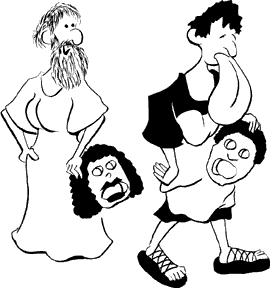
The masks probably helped a bit.
Roman and Greek plays had kind of a Kabuki look to them. Although the actors didn't wear make up, they DID wear masks that were designed to convey the particular character and even the mood. The masks also acted as mini-megaphones so as to project the sound of the actor's voice. In general, though, actors were not held in high esteem (certainly not hero worshipped as they are today), a standing which continued into the late nineteenth century.
The profession of the stage was limited to men. They took the roles of women. The masks probably helped a bit for the leading man.
The trouble was, by A. D. 79, neither of Pompeii's two theaters had been functioning for 17 years. They, like so much else in town, had been lying idle since the earthquake of A. D. 62. The townspeople had to focus on repairing the essentials buildings. The baths, the law courts, the markets, and, of course, the amphitheater.
The Amphitheater
The baths and the theater were places to go for low keyed enjoyment, rest, and relaxation. But if you wanted REAL excitement there was amphitheater. Pompeii has one of the oldest stone amphitheater of the Roman world. At the time it was built Rome itself was still futzing around with wooden structures that collapsed or caught on fire. Whether the populartion was ten or twenty thousand, everyone, literally, could fit into the amphitheater.
The main purpose of the amphitheater was to house the gladiatorial combats. Although sneered at by modern society who look on the games as proof the Romans were moral degenerates, the gladiators were actually the equivalent of our own rock and athletic megastars. Since they were officially slaves, they had the forbidden "bad boy" quality so common before the Rolling Stones got old and Elvis got fat. From all accounts the gladiators did indeed appeal to the ladies. They were, after all, hunks.
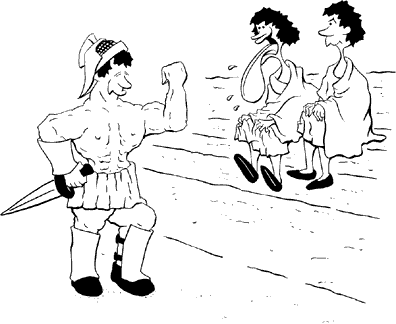
Hunks
There were different types of gladiators and they differed in the weaponry and amount of armor. The most heavily armored gladiator did not always win. Most people have seen pictures of the retiarius, the guy with the net and trident. They were traditionally pitted against a more heavily armored - and therefore more clumsy - opponent. Agility and speed could sometimes win against armor and steel. But not always. There's one story of how the retiarius cast the net at his opponent - and missed. Then he ended up running around the arena while no doubt the crowd hooted and jeered. There were also women gladiators and their bouts - like female mud wrestling today - were particularly popular with the men.
Originally gladiators were selected from the prisoners captured in Rome's near continuous wars. In antiquity, there was no Geneva convention, and prisoners were NOT released at the end of hostilities. Instead they were sold as slaves (which was one way the conquering generals got rich). So if you were taken prisoner you might easily end up working in the mines, sweating in the fields, or (even worse than anything), rowing the galleys. So being selected a prisoner to be a gladiator was actually giving them kind of a break.
The advantages were real. First, if you managed to survive for three years you would get your freedom. Although not easy, it could be done, particularly if, as some authors say, like modern boxers gladiators only fought two or three times a years. And like modern boxing, each bout had definite rules and there was a referee to make sure no one pulled any dirty stuff. Furthermore unlike in the movies most of the gladiators did NOT - repeat did NOT - fight to the death. If one got to tired or was cornered by his opponent, he raised his (index) finger as a sign of surrender. It was then up to the master of the games (advised by the crowd) to decide his fate. Draws were also common.
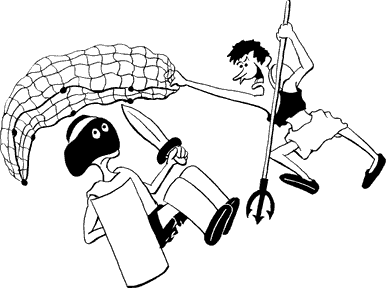
The most heavily armed gladiator did not necessarily win.
All in all the odds of surviving any given combat were very good - between 80 and 90 %. For instance, once when eighteen gladiators were paired up, nine won, six were spared, and only three were given the pollice verso or turn of the thumb (this MIGHT have been the "thumbs down" of historical fiction, but nobody really knows what the actual signal was). So if you fought say, eight matches in three years, those odds gave you about a one in four chance of making it to freedom. Not great, but not that bad either, all things considered.
Also when (or rather if) a gladiator retired he likely would do so rich. For instance, if a wealthy patrician had bet 50,000 sesterces on you and you won, he'd likely give you a generous tip. "Tip" is probably an understatement since it would probably be several times more than a small business took in a year. Also there are stories of mature Roman matrons slipping off to a keep an appointment with a current gladiatorial favorite. You can bet that after the rendezvous something more substantial than a "thank you" was given. At one point gladiator's pay got so high that the emperor had to decree no gladiator could be paid more than 20 % of what his owner paid for him. And when they retired they might even be granted a pension.
So it's not surprising that a number of gladiators returned to the arena after their three years were up. Some particular favorites even came out of retirement . And as time went on, some free men - either for the money, the glory, or the feminine attention - VOLUNTEERED to be gladiators. So the gladiators' situation was not necessarily the worst that could happen to an inhabitant of the Roman Empire.
Gladiators were only one group of people to perform (so to speak) in the arena. The second - and more numerous class - were criminals convicted of capital crimes. It was this form of entertainment (along with the animal "hunts") that can honestly be classified as a slaughter. Murder, arson, robbery, and treason could get you the death penalty, standards not too much stricter than we have today and no different at all than in Europe in the Middle Ages where death by torture was the norm. And in early America up until the 1700's, a simple misdemeanor might get you put in the stocks with your ears nailed to the headboard. And if you were convicted of ANY felony, you got the death penalty.
Sometimes the condemned were made to fight each other until all but one were wiped out. What happened to the last one isn't clear. Maybe the prisoner was let go or simply dispatched either by a trained swordsman or by one of the wild beasts that were only second in popularity to the gladiators.
For the animal entertainment the traditional picture is that the prisoners would be herded up to the arena and the lions (or whatever) would be let loose. Contemporary accounts and illustrations, though, show the prisoners bound to stakes or rolled out in wheeled carts where the animals could pick and choose. In any case, all this was usually done over lunch and was kind of the equivalent of half time.
That doesn't mean that if the crime wasn't too bad you might not be let off. Once a man was convicted of fraud (again a version of robbery). He was hustled up from his cell to the arena and a lion cage was hauled out. The door was raised and out popped a chicken. The man fainted and the crowd went hysterical. The emperor then cried out that the man had defrauded the public and so had been treated in like fashion. He was revived and turned loose. Or so the story goes.

Wild beasts in the arena
Included the "criminals" were the Christians. Despite popular belief, it was NOT the religion itself that raised the Roman's hackles. Romans were probably the most tolerant society toward new religions that has existed before or since. But the problem was the Christians refused to obey certain laws whose refusal constituted treason. The law that caused most of the trouble was the one where everyone had to throw a pinch of incense into a fire or pour a glass of wine onto the ground before a statue of the Emperor. They could not, the Christians said, worship the Emperor (Jews, by the way, were exempt from this requirement). The Romans tried to reason that this wasn't worshiping the Emperor. It was, they said, just acknowledging him as divine ruler of Rome; sort of an early form of loyalty oath. This was, though, a distinction the Christians didn't buy.
Were Christians ever put to death in Pompeii's amphitheater? Probably not. At that time they were considered nothing but a nutty fringe cult, and if there were Christians in town at all, they would have been pretty much ignored.
The biggest problem with the games, at least in the government's opinion, was the crowds. Like in modern sports competitions, they could get unruly. Twenty years before the eruption, there had been a gladitorial game between Pompeii and nearby Nuceria with Pompeii playing the host. Pliny's friend Tacitus wrote about it and said a "trifling incident" gave way to taunts and then to insults, stone-throwing, and finally drawn swords. The more numerous Pompeians came out ahead, but after the matter was investigated by the Senate they banned gladitorial combats from Pompeii for ten years. It seems though that this ban didn't stick since the Pompeians wouldn't have repaired the amphitheater so quickly after the earthquake in A. D. 62 if it hadn't been used for something. In any case, the Pompeians had at least a few years of entertainment before Vesuvius finally blew up.
August 24, A. D. 79
Or maybe it was August 22. Who knows?
Anyway, it was about 1:00 on one of those days that Pliny the Younger's mom, from a vantage point at Misenum across the Bay of Naples, pointed out to Pliny's uncle a "cloud of unusual size and appearance". At that time she and her son had been living with her brother who was the admiral of the Neapolitan fleet. The elder Pliny (commensensically called "Pliny the Elder" and a naturalist and author of considerable fame) had been working on his books. He got up to see for himself what was going on. He quickly saw this was no ordinary cloud and whatever it was was worth a closer look. He asked his namesake nephew if he wanted to go with him. The younger Pliny (who was and always remained something of a nerd) said, no, he'd rather keep doing his lessons.
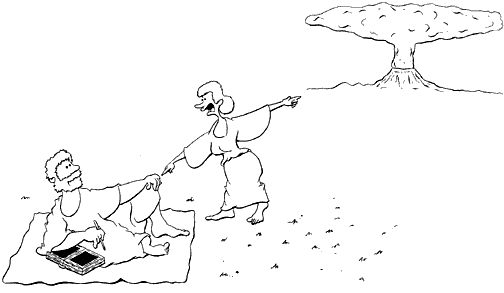
A cloud of unusual size and appearance
Before Pliny the Elder could leave he got a note from one of his friends asking him to come rescue her. She lived at the foot of Vesuvius and said she couldn't get away. How the heck a messenger could have gotten away but she couldn't isn't all that clear. But Pliny to do what he could.
The boats were cast off, and Pliny headed toward Vesuvius. He might have been sailing toward the town of Herculaneum which at the time went right down to the shore. But when he got there he found that the waves were too rough and besides the pumice was blocking the way to shore. He headed toward Stabiae (four miles south of Pompeii) where he could park his boats.
He found some of his friends cowering in a house not knowing whether they should run or try and stick around and ride the eruption out. Finding himself surrounded by a group of hysterical terrified provincials, he told them not to worry. Why those massive sheets of flame rolling down he mountainside were nothing to worry about. Probably they were just fires set by the peasants. Or something. He to take a bath and go to sleep, which he did since everyone could hear him snore.
Finally prudence (and the fact the house was about to collapse) prompted everyone to get the heck out of there. So they woke Pliny up, which was a good thing because so much ash had fallen in the courtyard he almost couldn't make it out of the door (he was, after all, pretty hefty). Everyone headed toward the ships. But when they got down to the beach they found the earth tremors were still making the sea so rough they couldn't leave. Pliny wasn't feeling too good by this time (he was probably having a heart attack), and so they spread a blanket on the ground so he could lie down. Suddenly everyone noticed a sharp sulfur odor and figured if they stuck around they'd all be asphyxiated. They tried to help Pliny up, but as he leaned on two slaves he finally collapsed for good. Everyone took off down the beach.

They tried to help Pliny up.
Meanwhile back at Misenum ...
The younger Pliny and his mom had stayed in their house. Later Pliny took a bath and went on to sleep although he did so fitfully. Probably around 3 a. m. the roar of the eruption and the shaking of the bedroom made it impossible to sleep any longer. He was just getting up as his mother came into the room. They went out and sat in the courtyard, which seemed the best place to be since the house was quaking so bad they thought it might fall down.
With nothing to do Pliny asked one of the slaves to bring him scroll of Livy to read. As he set there taking notes a friend showed up and started chewing him and his mom out for sticking around. He urged them to leave and when they didn't he showed more intelligence than one of the greatest writers of all time and headed off for the countryside. Finally with the tremors at their worst and the house literally rocking back and forth, they it would be best to try to get to some safer location. They also took off toward the open country with a terrified crowd at their heels. Pliny was worried they would be crushed by the stampede so he and his mom turned off the main road. They found a place to sit and wait it out.
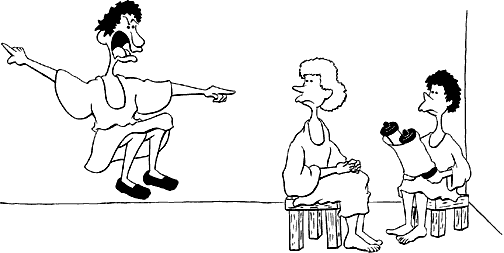
Their friend urged them to leave.
Looking back toward Vesuvius, Pliny saw a huge black cloud descend onto the bay and roll their way. Although it was day, the cloud soon obscured the sun, and it became pitch black just as if (as Pliny described it) they were in a closed room with no windows or doors. They could see nothing. Although the prevailing winds blow south in Naples (Misenum is west of Vesuvius), the ash falls were now so heavy that everyone had to stand up from time to time and shake them off. Pliny and his mom remained relatively calm, but just about everyone else was in total panic, wailing and carrying on and (literally) thinking the end of the world had come. Pliny himself wasn't so sure about that himself.
Finally in the afternoon the cloud began to blow away and light gradually returned. With the ash covering everything it looked like there had been a heavy snowfall. Slowly they managed to wind their way back home, but it was several days before Pliny learned what happened to his uncle.
And at Pompeii ...
Things had not gone so good. In fact by this time the whole city had been buried.
In the early days of the archeology of Pompeii, it was assumed that the city had been buried in ash that gradually sifted down from the volcanic cloud and that the people who stuck around had been killed by the poisonous gases venting from the mountain. At the time that seemed reasonable enough. But in 1902, on the island of Martinique in the Caribbean, the town of St. Pierre with it's 30,000 inhabitants had been snuffed out by a volcano in about two minutes. After they interviewed the three survivors, the geologists began to think that something else was going on. Indeed there was.
The Casts
One of the first things everyone learns about Pompeii is how the first archeologists discovered you could make plaster casts of the victims who had been caught in what was their last futile actions. Giuseppe Fiorelli, who was in charge of the Pompeii excavations from 1863 to 1875, first invented the method and Amedeo Mauiri (of whom most later archeologists seem to have mixed feelings about) developed the procedure further.
The idea is simple in principle. If you see a suspicious bump, drill a few holes, clean out the cavity as best you can, and then pour in liquid plaster of Paris. After three days chip away the outside and voila!, there you have it. A man crawling on his elbows. A dog chained to a post. Or even a man who had climbed a tree and was still hanging on to the branch for dear life.
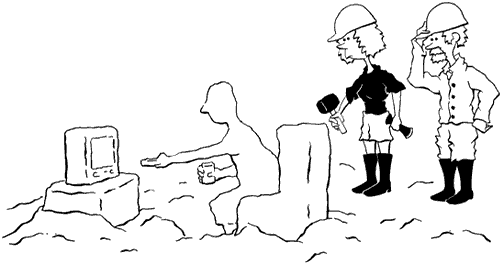
Their last futile actions
Some people wonder how if the Pompeians suffocated from poisonous gases or got flattened by lava how could the people could hold their poses for posterity. And even stranger, why do the people that have come to light show no signs of any injury?
The truth is that what did these people in was neither lava nor (necessarily) poison gas but two types of volcanic phenomenon identified only within the last hundred years: pyroclastic flow and pyroclastic surge.
What Pliny saw as a teenager was (as he correctly deduced) the volcanic cloud forced upward by the pressure of the blast. But a volcanic cloud is not a nice whispy puff of vapor that simply blows away. Instead, it's a humongous and dense mass of dust, rock, and gases blown 10 miles or higher at extremely high temperatures. The lightest material stays aloft for a while but then cools and rains back down as pumice. This stuff isn't usually dangerous to the people as such. At Pompeii, the pumice was so light that it could literally float on water. Even the heavier rocks, which prompted the people to put pillows over their heads, fell infrequently and would not have caused many casualties.
But once the force of a volcanic blast is exhausted the column of rock, dust, and hot gases falls back to earth. The heaviest parts land back close to the top of the volcano and have no place to go but down the slopes. So you have a bunch of solid rock and dust which are "fluidized" in super hot gases. As they roll down the slopes, the lighter ash and gases rise up and the heavier rocks hug the ground but still keeps moving. The lighter part is called a pyroclastic surge and the heavier part is the pyroclastic flow.
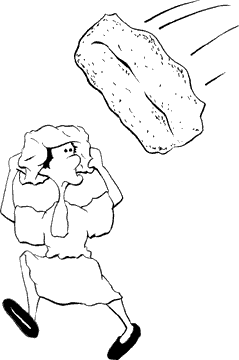
Even heavier rocks caused relatively few casualties.
A pyroclastic flow can move at speeds of 100 miles per hours (or more) and can flatten anything - buildings and people alike. But a pyroclastic surge, though, less destructive can be as deadly. For instance, if the surge is mostly hot gas with a little bit of dust you get a quick rise to deadly temperatures so that people can literally be burned to death so fast that they end up as rigid stiffened corpses. One of the three survivors of the 1902 eruption of Mt. Pelee described in gruesome detail what it was like to be caught in a surge and a photograph of a street in St. Pierre show the victims huddled and contorted much like the plaster casts in Pompeii. If in St. Pierre there had been a second ash fall they would have been covered up and eventually would have formed the molds like at Pompeii.
In the 1980's a geologist studied the layers of ash at Pompeii and figured out what happened. First, beginning around 1:00 on August 24, there was an ash fall of about four and a half feet of white pumice (this was the cloud the Plinys first saw). The pumice was light enough so that people were in no real danger and probably a lot of the population hung around until the buildings started collapsing. Although the pumice is fairly light, 4 feet of it would easily cave in the roof of a Roman building which did not have to conform to very stringent building codes.
A second ash fall was of a denser gray pumice and this layered another four feet on top of everything. The combined weight of these two falls would have been enough to collapse buildings even built under modern codes. So after eighteen hours there would have been only a few especially well-built buildings with enough roof or upper floors for people to take shelter. The gladiator barracks with their extra strong cells also held up and a number of people took refuge there. As it turns out, if your house collapsed and you had to leave, you were one of the lucky ones.
At this point there may have been a brief lull and some people may have returned thinking the worst was over. Or those who HAD been able to hang around to move out. But instead the second, denser ash fall was the precursor of the pyroclastic flow which rolled down the mountain as the rest of the cloud collapsed.
This is probably what Pliny the Younger saw when he saw the cloud roll toward them (his description and the timing agrees pretty much with what the modern geologists report). Pliny and his mom were far enough away so the force of the flow was spent and all they got was just the ash which rose into the air. The bay itself also probably blocked the flow from reaching all the way to Misenum and so long as everyone there kept their heads they were in no danger.
Not so at Pompeii. As the cloud fell down it took only a few minutes for it to reach Pompeii. There were in fact six flows. The first five probably didn't get beyond the north wall. But since pyroclastic flow is often preluded by the high temperature surge it's possible that most of the inhabitants had been wiped out by the time last flow hit the town.
It was probably the sixth flow that spilled into the town and beyond. The parts of the buildings that had not been covered by the ash fall were flattened and the people (whether they were alive or not) were covered as the stood, lay, or ran. After the last surge there was a smaller ash fall, maybe only a foot or so. But by that time Pompeii was long gone.
Pompeii Rediscovered
Of course, Pompeii wasn't just forgotten. People did return and tried to dig out their houses, or at least tried to get any money, jewels, or other valuables they left behind. Maybe some did.
The new emperor, Titus (he had been emperor only for a month and had just wound up a visit to Herculaneum), sent some envoys down to see what could be done. They thought about trying to dig out the town and rebuild it, but it quickly became evident that wasn't possible. Some people moved only a short distant to the neighboring towns, and others pulled up stakes and headed to other parts of Italy.

Rediscovered
After his uncle died, Pliny inherited the estate and changed his name to match that of his uncle adding "Secundus" (the Latin Equivalent of "Jr."). He eventually moved to Rome and wound his way through the various offices needed to become a successful uppercrust Roman. He even made the by-then watered down consulship at the age of thirty-nine - very young for that office. Although he seems a decent enough man, he did serve under Domitian who, while not the worst of emperors, certainly wasn't the best and indulged in political purges from time to time. Pliny's conscience seemed to bother him a bit about that.
The story is well known how in 1711 a well digger was (what else?) digging a well over Herculaneum and found what were clearly Roman artifacts. People began burrowing under ground and pulling out statues and other valubles. But it was the 1748 rediscovery of Pompeii itself that had the King (or whatever) of Naples sending his workmen to dig the goodies out with a vengence. So by the nineteenth century some of the best artwork (including the frescos) were adorning the palaces of the Italian nobility who probably didn't know versa latina from versa latrina.
We can probably thank Garibaldi for putting a stop to that nonsense. After Italy was finally reunited in 1861 (or pretty much reunited), the government could take over administering not only Pompeii but all other archeological sites in Italy. In 1863 Giuseppe Fiorelli was put in charge of Pompeii and kept up responsible and scientific excavations there until 1875. In the first part of the twentieth century, the long lived Amedeo Mauiri dominated the work. During his tenure (1923 to 1964) he was a definitely a dynamo, but he had a tendency to dig quick and not worry about what would happen once the buildings were exposed, particularly when there was no money available for their conservation. Still his job wasn't made any easier in 1943 when Pompeii was bombed by Allied air planes when they thought the Germans were hiding ammunition in the town.
What's funny (if you want to call it that) is that before A. D. 79 no one even thought about Vesuvius as a volcano. It had erupted about 1800 B. C., and everyone had forgotten about it. But after Pompeii was buried, Vesuvius started rumbling and it hasn't stopped since.
The total number of times it's erupted depends on your exact definition of an eruption. You can count over 200 significant events, meaning the mountain has spewed out ash, steam, and lava But some geologists consider only eighteen of those as "major", although it's probably better to count about thirty as "eruptions of note".
There were at least two eruptions (A. D. 203 and 472) while the Rome still ruled (the last only four years before the official "fall" of the Empire), and in the Middle Ages there were eruptions in 512, 787, 968, 991, 999, 1007 and 1036. After that Vesuvius settled down for about 500 years with only infrequent and minor events. Finally after a "small" explosion in 1500, it quieted down so much that people again began to forget it was a volcano.
But in 1631 the mountain really blew its top. As usual the number of people killed isn't clear but it was at least 3000 and could have been as many as 18000. After that Vesuvius went totally crazy and didn't go more than 7 years at a time without some activity. Notable eruptions averaged every 16 years: 1660, 1682, 1694, 1698, 1707, 1737, 1760, 1767, 1779, 1794, 1822, 1834, 1839, 1850, 1855, 1861, 1868, 1872, and 1906. Finally in 1944, in a widely observed, photographed, and filmed eruption, the mountain finally quieted down and has been dormant ever since.
But the ground around Vesuvius is still unstable, and it still keeps seismologists worried. In 1980 there was an strong earthquake that damaged parts of the surrounding cities including Pompeii. With more than a million people actually living right smack in the shadow of Vesuvius, plans have been put in place to clear everyone out if need be. Vesuvius is still an ornery and cantankerous mountain and could end up burying Pompeii again.
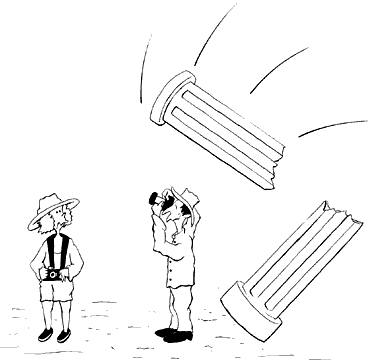
Pompeii - 1980 A. D.
References and Commentary
In the era of the Internet, many rare reference books can be found and at times amazingly cheaply - if you know how to search. The cost of the book (but in different editions) can rage from a couple of dollars to several thousand. The condition of the books is not always the main criteria for cost but, more what the bookseller thinks they're worth.
Books
"The Letters of Pliny the Younger" by Pliny the Younger, obviously. The most recent translation is by Betty Radice, published by Penguin Books in 1969 and issued in newer editions ever since. The translation is so good that Harvard's Loeb Classical Library (which has the original Latin facing the English) used her translation in their revised edition. Project Gutenberg also has an online edition of the earlier translation by William Melmoth and F. C. T. Bosanquet posted http://www.gutenberg.net/dirs/etext01/ltpln10.txt.
Three of the Pliny's numerous letters really pique the interest of the modern reader. Two, of course, are the quite long letters he wrote about the eruption of Vesuvius (he actually saw it). He mentions Stabiae, but not Pompeii.
And although it had nothing to do with Pompeii, Pliny wrote about the "troubles" he had with the Christians after he became governor of Bythinia (in modern day Turkey). This letter is the first indisputable reference to Christianity from a non-Biblical source and Pliny concluded Christianity was a "most depraved superstition carried to extravagant lengths". It sounds like Pliny learned of Christianity by watching Sunday morning television.
Pliny's letter deserves a bit more attention than normal in a footnote, mainly because his actions seem to belie his reputation as a legal whiz. He even comes off a bit scatterbrained. For one thing he admits he doesn't even know if he can legally "punish" (i. e., execute) Christians unless they have committed an actual crime or if he can go ahead and kill them just because they're Christians. But he then went ahead and killed them, anyway. THEN he wrote the Emperor and asked what he should do.
All this disturbs a lot of people who read that Pliny is a man to be admired, but you have to remember that the sandal finally fell to the other foot. Only 80 years after the last wave of Christian persecutions in Rome, the Christians had taken charge and began executing people THEY didn't like.
Pliny's other letters can be interesting but the reader can get rather lost when he deals with the contemporary Roman day to day politics. All in all he comes off as well meaning but a bit shallow.
"Roman Life in Pliny's Time", Maurice Pellison, Chautauqua-Century Press, 1897 - A fair amount of information and the illustrations came from the excavations at Pompeii. Published at the end of the last century, it was intended for people who wanted to improve their knowledge of history, art, and science. A physically well manufactured book, at the time of this writing original copies can still be bought in good (even excellent) condition from between $5 and $45. If you're really into the daily life of the Romans, you might buy a cheap copy.
As far as the content goes, it is a good enough book, but with the limitations of the era of which it was printed. Some inadvertent humor creeps in like when it compared Roman servants to our own domestics, obviously assuming every family has three or four. Also it comments rather disparagingly on the cruelty of the gladiatorial combats. This seems a bit odd since that was those were the days when the British thought nothing of shelling the spear carrying Zulus with howitzers.
"Pompeii", Amedeo Maiuri, Instituto di Geografico de Agostini, Novara (1951). "Pompeii" is obviously a popular name for books on Pompeii. This was one of the better mid-twentieth century books on Pompeii. Half of the book is text giving a good basic description of the town and the second half is composed of pretty good black and white photographs. Professor Maiuri was the leader of archeology at Pompeii in the mid-twentieth century. He made real strides in excavating the sites, but he has been criticized for the haste of his work and at one point he seemed more interested in getting a site dug up so the government could use the volcanic rock for road construction. A main problem is that he didn't do much in the way of conservation. So some of the places he excavated are the ones that have deteriorated the most.
If you get this book make sure it's the English version (unless, of course, you read Italian).
"Cities of Vesuvius", Michael Grant The Macmillan Company, 1972. A pretty good book with good illustrations. Michael Grant abandoned a distinguished academic career as a classicist (his last official post was Vice Chancellor of Queen's University in Belfast) to be a full time writer. A man with a way with words, for nearly 40 years he was (almost) the Isaac Asimov of ancient history. His books were (and remain) immensely popular with the public and are great reading for the history fan. Some academics, though, tend to trash his more popular books in their reviews. Michael probably cried all the way to the bank.
"Eros in Pompeii: The Secret Rooms of the National Museum of Naples", Michael Grant and Antonia Mulas (William G. Morrow Company, 1975). A bit more academic book by Michael Grant, and a very good one that put the more titillating (no pun intended) aspects of Roman life before the public. Although the Romans had a strict moral code, they were no more rigorous in enforcing it than anyone else. What this book brought to the front (again no pun intended) is how ubiquitous were depictions of the various body parts as you walked down any Roman street. The book is quite well illustrated by Ms. Mulas' color photographs, and by today's standards, is really pretty tame.
"Pompeii: The Vanished City" by the "Editor's of Time-Life" (whoever they are.) Not bad, but as usual for the more recent Time-Life books, a bit thin and superficial. Time-Life Books from the 1970's and earlier were much more informative, but now, of course, a bit outdated. In any case, Time-Life has degenerated from being a true resource for the popularization of science to pandering to increasingly credulous and superstitious populace. Check out their "Mysteries of the Unknown" books. Pure garbage.
"Pompeii: A Guide to the Ancient City", Salvatore Nappo, Barnes and Noble (1998). Probably the best starting place. Intended primarily as a guide for the visitors, it is up-to-date and written by one of the modern archeologists of the site. The book combines excellent text, high quality photographs, and artistic reconstructions to provide a detailed description of the city layout and the buildings.
"Cambridge Latin Course Unit 1", by Stephanie Pope, Stan Farrow, Anne Shaw, and Patricia Bell. An elementary Latin textbook may seem a funny place to find information about Pompeii, but the whole first unit is based on the (largely fictionalized) family of Lucius Caecilus Jucundus. Lucius was real, though, and there's enough information on Pompeii so the book has merit. If you buy it make sure you get the collected version since the individual chapters also come as separate booklets. The Latin part is for middle or high school students, and an adult might find reading the Roman equivalents of "See Dick run" rather tedious. The Latin self-learner is better served by the textbook by Frederick Wheelock which has a more mature tone. A personal opinion is the smaller earlier editions were better than the oversized ones you now see in stores.
The Cambridge books are a bit sanitized for the kiddies. They don't gloss over the bit about the slaves (part of the story has Lucius buying a pretty slave girl which didn't please his wife), but they also talk about how breakfast was a piece of bread dipped in water rather than wine (which even the kids drank). A more amusing bowdlerization is where the authors show a photograph of a "house" with the roof still intact and explain how the Pompeians expanded the upper floor space by having the second story extend over the street. True enough, but they neglect to mention that the house in the picture was the lupanar.
"Pompeii's Erotic Songbook", Francisco Paolo Maulucci Vivolo, (Plurigraph Narni, 2001). Probably an unfortunate title as this is in the same league as the book by Salvatore Nappo and the author is an bonafide archeologist who at the time of writing worked at the Pompeii excavations. The topic is the more raffish graffiti (hence the title) and frescos at Pompeii. For the people with traditional family values this is probably NOT really for the kiddies - a comparison of the paintings - although not quite so stunning as what you might find on the Internet (so I hear) - shows truly that nihil novum sub sole. Seems to be a rather hard-to-find volume.
"Volcanic Hazards : A Sourcebook on the Effects of Eruptions", R. J. Blong, Elsevier Science and Technology Books, (1984) Lists the most deadly eruptions and estimates of how many people were killed. The figure for Pompeii is given as 3400. This might be as much an underestimate as is Prof. Maiuri's an overestimate (see below). In any case, there's been about 1600 bodies found in Pompeii and about three hundred in Herculaneum. But guesses on fatalities in early eruptions are just that. The deaths at Herculaneum are listed from almost everybody to almost nobody.
Best to read this book in a library. It's rare and expensive.
Magazine and Newspaper Articles
"Last Moments of the Pompeians", Amedeo Maiuri, National Geographic Magazine, November 1961, pp. 651 - 669. An article by Professor Maiuri himself. He was responsible for preparing the plaster casts of many of the victims from the ash, but his estimation that 16000 Pompeians died is in modern opinion about 14000 too many.
Always the butt of many rather puerile jokes, National Geographic remains the premiere magazine for the armchair traveler. There was (and has been) a need for a bit more meat and less padding as the authors seem to like to muse on the pathos as they walked about the town. One college textbook on English composition used the introductory paragraph from a National Geographic article as how NOT to write.
"The Dead Do Tell Tales at Vesuvius," Rick Gore, National Geographic, May 1984, pp. 556 - 625. An article about the findings in the 1980's particularly at Herculaneum where archeologists found a large number of skeletons down by the original beach front. Although the town is much closer to Vesuvius than Pompeii the ash fall was not as heavy and so more people may have tried to ride the eruption out. But the pyroclastic flow was naturally worse and until more excavations are carried out no real estimate can be made on how many people died. One problem is the modern town of Ercolano sits on top of the ancient city and so makes excavations much more difficult.
"A Fish Tale from the University of Bradford", Press Release, University of Bradford, January 2002. Covers the discovery of the first entire fish skeleton at Pompeii in a jar that was probably a garum fermentation vessel.
"Five-Star Inn with Great Art", Judith Harris, Archeology Magazine, Volume 53 July/August 2000. A brief summary of the (re)discovery of a fancy hotel outside of Pompeii. This sounds like the same place they found the records of Lucius Jucundus, but because the government wanted to put in a freeway they had to rebury the site. This was back in 1959 and it took 40 years for the site to be reexcavated.
"The Eruption of Vesuvius in A. D. 79: Reconstruction from Historical and Volcanological Evidence," Haraldur Sigurdsson, Stanford Cashdollar, and Stephen R. J. Sparkes, American Journal of Archaeology, Volume 86, Number 1, January, 1982, pp 39-51. This is THE paper about what happened at Pompeii, volcanically speaking. Before then people thought Vesuvius just covered Pompeii with ash and Herculaneum was buried in mud. This is a technical paper and likely you local neighborhood library won't carry the journal. If you have some friends going to college, they might be able to order a copy for you if you're willing to pay for the cost and copyright fee (which probably won't be much).
"Plumbing in Pompeii and Herculaneum," Plumbing and Mechanical Magazine, June 1993. Covers the history of Roman plumbing using finds of the Vesuvian cities. The web site http://www.theplumber.com has the history of plumbing divided into the regions and the different civilizations.
"Classics Ireland," A classics scholarly journal. A lot of good articles particularly "Brothels, Baths, and Babes: Prostitution in the Byzantine Holy Land". Although a bit later than the era of interest here, much of the article is timeless.
General Life in Roman Times
A number of "Daily Life in Rome" books have been published over the years but not until the last quarter of the twentieth century were the authors able to broach on subjects that were traditionally considered unfit for women, children, and delicate men.
"Daily Life in Ancient Rome: The People and the City at the Height of the Empire,", Jerome Carcopino (Yale University Press, many editions). The standard "daily life" book that still seems to be held in fairly high regard by contemporary classicists. As befitting the author's generation (Edwardian) there's numerous gibes and jeers regarding the Roman's brutality and immorality and rather tedious moralizing. But still a lot of information on how the Roman's lived.
"The Private Life of the Romans", Harold and Mary Johnston Scott, (Foresman and Company, 1932). One of the the pre-WWII looks at Roman daily life and pretty comprehensive if you realize that this was printed at a time when James Joyce's Ulysses was banned in the United States. So although you can get the basics, the book steers away from how the Roman's made whoopee. The authors do, however, talk about the Roman's underwear which probably wasn't really underwear.
At the time of this writing there was a free online edition at http://www.forumromanum.org/life/johnston.html
"A History of Private Life: From Pagan Rome to Byzantium", Peter Veyene, Editor, (Harvard University Press, 1987). A bit more contemporary treatment, and quite an eye-opener for those who think of Rome as the stately ordered society seen in the movies. You learn that despite the kudos tossed at Rome for having it's laws and institutions, it was really an anarchistic and dangerous place where might literally made right. Compared to Rome, Central Park at 3 a. m. is like Dubuque on a Sunday afternoon. It also covers the (to us) more unpleasant aspects like how infanticide was legal and commonly practiced throughout the Roman era.
"Looking at Lovemaking Constructions of Sexuality in Roman Art 100 B.C - A.D. 250", John R. Clarke, University of California Press, Berkeley,1998). The first volume of a study on exactly what the title says. Not bad, but the second volume (see below) is better.
"Roman Sex, 100 B.C. - A.D. 250", John R. Clarke and Michael Larvey, (Abrams, New York, 2003). Volume 2 of Prof. Clarke's books on making bam-bam in ancient Rome.
"The Latin Sexual Vocabulary", J. N. Adams, (The John Hopkins University Press, 1982 and other editions) . What you didn't learn in Latin 101. Covers the taboo words, various euphemisms, and on to the more picturesque expressions. For a people who didn't mind having statues of naked people, renderings of standing body parts, and paintings of folks actually in the act decorating their towns, public buildings, and even private homes, the Romans could be surprisingly prissy. Augustus even banished Ovid, one of the most famous Roman poets, to a Greek Island just because one of his books had a rather inoffensive "how-to" chapter for young ladies. The book wasn't banned, mind you, just Ovid.
"Gladiators: The Bloody Truth", Michael Grant (1967, reprinted Barnes and Noble, 1995). A small introduction to the historical gladiator. As usual for Michael's books, it's a good starting place but Michael has definitely produced better. For one thing it takes a surprisingly moralizing stance which leads to a somewhat contradictory tone. For instance, he talks about how the Christian humanitarianism helped suppress the games while in the same paragraph talking how the first "Christian" emperor (note quotes) thought nothing of throwing captured German prisoners into the arena to be torn apart by wild animals, a la Nero and HIS Christians. The truth seems to be that the games petered out because Rome was crumbling and couldn't afford to keep them going.
Constantine, by the way, had quite a strange way showing he was filled with the Holy Spirit. He not only permitted the gladiatorial games (although they were no longer financed by the state), but murdered his son, facts official church histories either ignore or strain a bit to justify.
"The Way of the Gladiator", Daniel P. Mannix, (Simon and Schuster, 2001). (Original title, "Those About To Die", Ballantine, 1958). One of those books that went out of print and was rushed back in after the movie "Gladiator" was released. A "fictionalized" account with a lot of invented scenes and dialog although it makes no pretense to be otherwise. You have to be a bit skeptical, though, that the reason the author doesn't list a complete bibliography is because there are just used too many sources. Try getting THAT argument past an academic referee. Also you have to worry that at least part of his recreations were based on information from a Mexican producer of what were then called "stag" films.
The trouble even with using primary Roman sources is that many of the writers were satirists, humorists, and novelists and so it's kind of difficult to see how much is true. How would future historians write about the US Air Force if their only source was "Catch 22"?
"The Dying Game: How Did the Gladiators Really Live?", John Follain, (The London Times December 15, 2002). An article based on the finding of a gladiator cemetery in Ephesus. The new "revisionist" position seems to be that gladiators were vegetarians who from their diet probably suffered from flatulence and were pudgy. But that their diet was heavy on barley is also mentioned in Michael Grant's book. Many "new revelations" you read in the papers are often simply rehashing facts known for years.
"A Dictionary of Greek and Roman Antiquities", William Smith, 1875, A "classic" reference work but some of the definitions don't seem to gibe with modern scholarship. Copies can still be bought and range from $10 to $500. But why bother? There's an online version at http://penelope.uchicago.edu/Thayer/E/Roman/Texts/secondary/SMIGRA*/home*.html
Internet Resources
Although Internet resources tend to be more short lived and of questionable reliability, the following seem to be more stable and are written by true authorities on the subject.
"An Eyewitness Account of the Disaster" on the Cambridge University Faculty of Classics web site at http://www.classics.cam.ac.uk/Everyone/Pompeii/Destruction.html has Pliny's two letters in a Latin/English side-by-side version. They use the translation of Professor Cynthia Damon of Amherst College.
"Mt. Vesuvius Online", http://www.vesuvioinrete.it/e_index.htm This is the web site of the Vesuvius observatory. A lot of information about the historical eruptions.
"Ostia - Harbour City of Ancient Rome", http://www.ostia-antica.org/, Jan-Theo Bakker (Webmaster). People forget Pompeii isn't the only archeological site in Italy. Cargo to and from Rome went through Ostia which was eventually abandoned leaving buildings standing to be slowly covered by natural processes. Prof. Bakker also has a good paper at http://home.wanadoo.nl/~jantheob/privrel/ about the types of buildings at Ostia which helps sort out the different types of restaurants, bars, and hotels the Romans had.
"Roman Clothing", Barbara McManus: http://www.vroma.org/~bmcmanus/clothing.html A detailed description of Roman clothes and styles. This is part of the Virtua Roma (VRoma) web site at http://www.vroma.org/.
"Roman Numeral and Date Conversion" by Stephen Grubbs at http://www.guernsey.net/~sgibbs/roman.html. This is what it says and even has a on-line test for Arabic to Roman numerals (and vice versa). Also conversion from Julian to Gregorian dates and vice versa. A very nice web site.
"Pompeii Forum Project", http://pompeii.virginia.edu/ This site contains an easily understood description of the stages of the eruption and points out that the first ash fall - which didn't present much danger to the people - had caused the roofs of most of the buildings to collapse before the deadly pyroclastic flows and surges arrived. So most of the Pompeians almost certainly got away. Also a rather lengthy (but interesting) article on the nature of pyroclastic flow particularly at the 1902 eruption of Mount Pelee in Martinique. The rather grisly picture of some of the victims and an equally grisly first hand account of one of the (three) survivors is included.
"Internet Ancient History Sourcebook", Fordham University. http://www.fordham.edu/halsall/ancient/asbook.html. A lot of full texts of ancient authors. Inscriptions (including graffiti) are at http://www.fordham.edu/halsall/ancient/pompeii-inscriptions.html.
"Pyroclastic Flows and Surges", www.geo.umass.edu/courses/ volcanology/Pyroclastic%202.pdf Although the basic paper on the the different phases of the eruption were first published in 1982 (see above), it's lack of accessibility may be a problem for the armchair vulcanologist. These are class notes form the University of Massachusetts and talk about what happened in Pompeii in some detail.
"Women at Ostia and Pompeii", David Noy, http://www.lamp.ac.uk/~noy/roman16.htm. A course outline from the University of Wales. Plenty of book resources listed plus some inscriptions that show how women of Pompeii did not just stay at home and take care of the kids.
"Feminae Romane",http://dominae.fws1.com/. "The Forgotten Woman: The Working Roman" at http://dominae.fws1.com/Forgotten/Index.html is particularly useful.
A website for two television specials, "The Riddle of Pompeii" and "The Hidden Scrolls of Herculaneum" is at http://www.channel4.com/history/microsites/P/pompeii/ with information on the Vesuvian eruptions.
"The Victims of Vesuvius: A Window on Equinimity in the Roman World", C.P. Craig at the lengthy URL http://notes.utk.edu/bio/unistudy.nsf/0/8c56a2c5ae52125d852565d9006bb4bd?OpenDocument. A perfect example of how you can be fooled on the Internet (and elsewhere) if you aren't careful. This seems to be a perfectly serious study if you come across this web page while a-browsing and you'll might agree with the righteous indignation of the author regarding how the "truth" is being suppressed. But then go read "The Centaur Excavations at Volos" at http://web.utk.edu/~blyons/centaur.html and you see it's a part of an on-going academic joke. Or sort of a joke.
"History of Ancient Rome", Garrett Fagan, The Teaching Company. For anyone who likes watching the tube but want to learn, nothing beats The Teaching Company's courses. These are a series of lectures by college instructors and you'll be amazed how entertaining it is to watch and listen to a guy or gal standing at a podium. Of course, there are visual aids, photographs, and sometimes videos to enhance the lectures. Professor Fagan's course on ancient Rome is one of the best and is composed of 48 half hour lectures. Although the "official" costs of the courses can be pretty steep you can almost always buy them significantly discounted.
Text and Images Copyright 2004, 2005 Charles F. Cooper